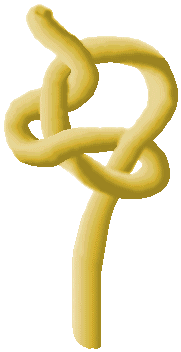 |
Gwyntarian Archers Guild |
 |
Gwyntarian Archers Guild |
 |
Tips on Technique |
|
The following is a collection of tips from various sources, mostly from postings to archery newsgroups, circa 1998 to 1999.

Breathing. Releasing the string at the same point in the breath each time places the rest of the body in the same position. Different breath point and the whole caboodle is changed. Holding the breath during the speed round deteriorates the stability as the time goes on. -- Franz I think that in speed shooting it would be to work on aiming first and speed second. It doesn't matter how many arrows you put down range if none of them hit the target. -- Conyan Do the same thing every time in every aspect and you eliminate variables. Shoot shafts that are the same. Draw to the same point. Aim the same. Release the same. Follow through the same. -- Guy Shoot the number of arrows that will give you the highest score. For example:
4 arrows 15 points 5 arrows 18 points 6 arrows 20 points 7 arrows 16 points 8 arrows 12 points
Robert's advice to forget speed is advice I've given for years, and in the words of my friend Colin Ursell, "It's not a speed shoot, it's a TIMED END." John's chart of quantity vs. quality (points) is really valid, especially as a strategy for archers trying to achieve a specific point goal, and YES the cock feather DOES NOT really matter. I'd sum up my agreement with these folks and my own advice with the following: Don't do anything differently in a timed end than in an untimed end. Keep every bit of your good form as smooth as you can, just speed up the whole process. Several well placed shots with no fumbling in between are worth more points than a dozen shots sprayed all over the range! Safer too... -- Ygraine
 I teach that the destination of the arrows on the target doesn't matter. The important concept is how tight your grouping is and that the grouping appears at the same place each time. The location of the grouping indicates your form. Moving the grouping is a minor adjustment in your form... relaxing is key. Habit of form is also key. I have developed a technique where I pull back the arrow as I am aiming the bow (from down to the target). My objective is to have the bow at the correct height and horizontal position by the time I have a full draw. This is known as a 'quick draw' in combat archery arenas. -- Lord Thomas Archer
 I shoot a version of instinctive shooting and when I am "on", the target is so in focus that all else nearly disappears from mind. A further definition is where a very small area of the target is really "seen". As long as the whole target is perceived, your concentration is not as deep as it could be. And no, you are not so zoned in that you become unsafe. By what ever style of aim and release you have, it's that sight picture of the target, bow, and arrow combined that is my answer to your question. Next most important is this: the motion of the string hand in release and arrow knocking should be practiced enough to become 2nd nature, virtually automatic and error free, allowing more concentration on the sight picture. As you learn a certain hand action, you will find out if you have a style which allows more arrows to be handled. -- Michael Van Bergen
 You don't teach "instinctive shooting", you teach draw, release, stance, and the special requirements for your equipment, as well as teaching why archery works, what effects changes in gear will have, changes in technique, etc... Instinctive shooting is best described in the Zen philosophy - if you do everything right on your end, the target stands no chance. As for a sight picture, there is a difference between sighting and having a sight picture. What I am describing is a subconcious (instinctive or spinal) pattern recognition. You see the entire picture, you recognize relationships between objects and distances and movements, and you just sort of 'know' when the bow is in the right place in this picture, and you shoot. Of course, it helps to really get to know the type of target you are regularly going to be shooting. The brain makes calculations you can't even begin to quantify while making ballistic judgements - you judge the age of the animal you are hunting, you estimate the size that animal should be, you then calculate distance by using the stereoptic feature of your two eyes. You judge the location of the target in the vertical plane, figure in wind, rain, other atmospheric anomalies, then you raise your bow and your brain fits all the information together into a picture and when the bow reaches the right place, you release. This is not sighting down the shaft or off marks or through sight windows, it is just knowing your gear well enough to make it all happen. And the brain is complex enough that it can learn to do all this in a relatively short amount of time - all you have to do is throw about a hundred arrows a day downrange for 2 to 3 weeks (without sighting, just trusting your instinct) before you start seeing and feeling what instinctive shooting is all about. It is critical for the success of an instinctive shooter to know technique and style inside-out, and to be able to recognize without thinking how to adjust the body to make things happen. You cannot teach hitting the target - that has to be learned by the shooter. You can and must teach the theory behind archery - that is where the shooter gets the info to be successful. -- Kaz - Chris Nogy <cnogy@dicksonstreet.com>
|